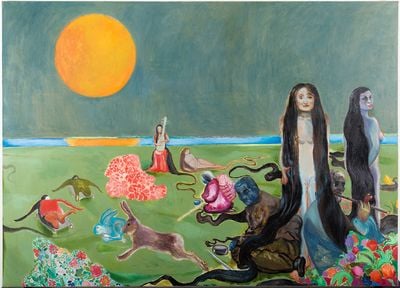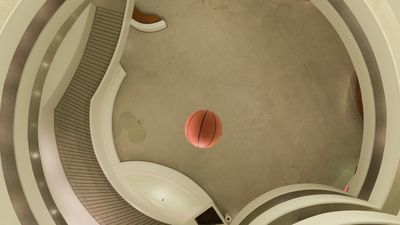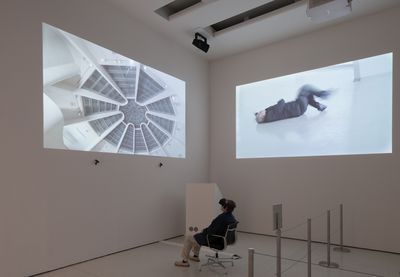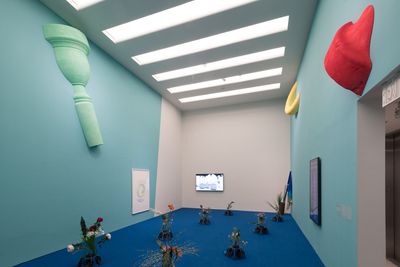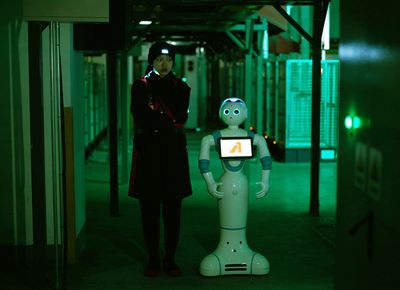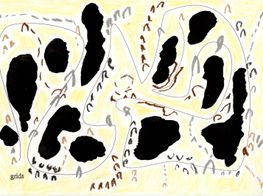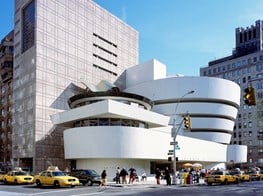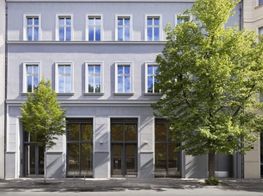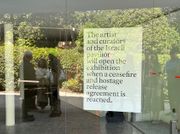One Hand Clapping at the Guggenheim Museum, New York
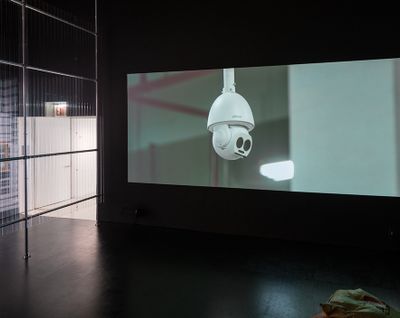
Cao Fei, Asia One (2018). Multi-channel colour video installation, with sound. Dimensions variable. Solomon R. Guggenheim Museum, New York. The Robert H. N. Ho Family Foundation Collection 2018. Exhibition view: One Hand Clapping, Solomon R. Guggenheim Museum, New York (4 May–21 October 2018). Photo: David Heald © 2018 The Solomon R. Guggenheim Foundation.
In the catalogue for One Hand Clapping, the final in a trilogy of commission-based shows focusing on art from Greater China organised by the Robert H. N. Ho Family Foundation and the Guggenheim Museum New York (4 May–21 October 2018), curator Xiaoyu Weng poses what she admits is a provocative question to consulting curator Hou Hanru: 'Do you think people are still interested in Chinese art?'
The two are long-term collaborators, and their appointment in 2015 as curators for the Guggenheim's Robert H. N. Ho Family Foundation Chinese Art Initiative was a canny move. If anyone can rescue a term like 'Chinese art'—which seems overdue for retiring—it is Weng and Hou, though what might replace the term is unclear. Weng boasts a track record of global commissions that lean toward discussions on technology and media. Hou's storied career has consistently decentred the founding narratives of Chinese contemporary art, often by displacing national perspectives with transnational intersections.
Both Weng's and Hou's curatorial approaches intertwine in this show. Its title is an allusion both to the old Japanese zen koan—'What is the sound of one hand clapping?'—and to Cantopop hero George Lam's anthemic 1996 hit about unrequited love. This doubling of old and new, high and low, sets the tone for the exhibition's theme: uncertain futures. Drawing on a vague if widespread sentiment that China is somehow the way forward, the exhibition's catalogue is peppered with references to theoretical trends like accelerationism and futurism. A set of keywords, provided to the artists to kickstart the commissioning process, stand in for a curatorial theme: 'future, technology, system, myth, ghost, groundlessness, disaster, chaos, absurdity, uncanny, medium, togetherness, existence, humanity, and utopia.' These ideas have purchase in the region the show's artists call home: the Pearl River Delta, recently renamed to the Greater Bay Area, and the ground zero of China's export manufacturing. Lin Yilin and Cao Fei are both from Guangzhou, where Duan Jianyu studied and settled; and Wong Ping and Samson Young are from Hong Kong.
Wong Ping's single-channel video Dear, Can I Give You A Hand (2018) is one of five large-scale commissions laid out over the Museum's Tower Levels five and seven. Projected onto an elaborate sculptural screen with an overflowing pile of denture-shaped wind-up toys behind it is a film containing the usual admixture of graphics that Wong Ping employs, recalling the glory days of Adobe Flash. The voiceover performs a diaristic diatribe by an 80-year-old man who lives in a world where old age is criminalised, centring on the narrator's decision to throw out his lovingly amassed collection of porn VHS tapes. In Wong's dystopian narration, the old must make room for the new—it's a theme that resonates with the sense of unease that Hong Kongers feel about their gradual marginalisation within the hegemonic idea of China.
Sharing the airy, high-ceilinged chamber with Wong's animation is Duan Jianyu's eclectic oil-on-canvas paintings that cover the walls, which appropriate motifs from classical ink-painting, fauvist palettes, and the schmaltzy feel of socialist realism. Titles like Spring River in the Flower Moon Night 1 (2017) offer a purposefully awkward allusion to a Tang Dynasty poem by Zhang Ruoxu: this painting features an egg-yolk moon, slate sky, ghostly maidens playing the lute and reclining nude, and rabbits frolicking among thickly painted floral patches. The exhibition catalogue suggests that the corny classicism in Duan's fantastical scenes is anything but outdated; they are inspired directly from the cultural production of young migrant workers, from the prominence of old tales in the online serial novels, karaoke-ready pop, and wuxia fantasy games that circulate over 4G connections across China. There is a playfulness to these haphazardly stacked compositions. But the intensity of their colouration, not to mention their dense hanging, also suggests a high-keyed anxiety behind these depictions of absurd leisure; from between the cracks of escapist fantasies, a morbid picture emerges.
Similarly, Weng's catalogue essay takes its title from a generic term that refers to 'poetry and distant places' as a way of describing aspirations that briefly lit up the Sinophone internet. The phrase is mawkish and self-deprecating on purpose, as if admitting the impossibility of upwards mobility in a post-communist social order that has within one generation calcified into inequality. As the poet Xu Lizhi, who became famous after his 2014 suicide while working at Foxconn, put it: this is a generation of 'screws that fell to the floor / on this overtime night'.1 Xu, one of several poets reproduced in the catalogue, is an explicit influence on Duan. Against the background of social transformations unleashed by capital-intensive technology, several of the exhibition's artists consider how working culture changes as the nature of labour evolves.
The final work of level five is sequestered behind a temporary wall from Wong and Duan's contributions. Conceptual artist Lin Yilin's three-part series is titled 'Monad' after German idealist philosopher Gottfried Leibniz's term for the basic substances of reality, which each mirror the universe as a microcosm. This project is distributed across a variety of media, including VR headsets, projected screens, and textual documentation, all linked by a philosophical obsession with basketball.
In The First ⅓ Monad (2018), we watch a drone drop a basketball down the centre of the Frank Lloyd Wright-designed rotunda of the Guggenheim Museum. In The Second 1/3 Monad (2018), Lin reprises his performance of rolling across the world's public squares by rolling up the rotunda of the Guggenheim, measuring space with his body. Finally, in The Third ⅓ Monad (2018) a 360-degree video stages an encounter with a virtual Jeremy Lin, the Taiwanese-American NBA superstar. These are displayed via projection, screen, and headset respectively—a somewhat eclectic range of media that detracts from the simplicity of Lin's practice. Lin's earlier performances were often pointed reflections on urbanisation's alienating effects; for Safely Maneuvering Across Lin He Road (1995), he safely jaywalked by standing behind a small temporary wall that he shifted brick-by-brick from one side of the road to the other. His inclusion of an Asian-American pop-cultural reference in the form of Jeremy Lin is a first, and suggests that since moving to the United States his interests have shifted towards experiences of alienation in a new society.
On level seven, Samson Young's Possible Music #1 (feat. NESS & Shane Aspegren) (2018) consists of a dispersed arrangement organised around a central conceit: impossible instruments. Working with the acoustic software of Edinburgh-based laboratory NESS (Next Generation Sound Synthesis), Young simulated the sounds of brass instruments that would have been physically impossible to construct, like a 20-foot trumpet or a bugle activated by 300ºC breath. These eerie sounds emanate from sculptural speakers sprouting fake flowers that dot the blue-carpeted floor, while pastel-toned walls sport drawings and a screen that sketch out these fantasy instruments: one video shows a dragon in a Pokemon-like stadium streaming fire into a floating bugle.
This kind of speculative and affective subtlety is typical of Young's installations. If there is a political project here, it's in the refusal of a future foreclosed that a generation of post-1997 Hong Kongers have grown up steeped in. This might seem like a stretch, but consider the pithy phrase mounted in pink neon at Young's 2016 solo show at Kunsthalle Düsseldorf: 'NOTHING WE DID COULD / HAVE SAVED HONG KONG / IT WAS ALL WASTED'. The search for possible sounds produced by impossible instruments, seems to resist dystopian inevitabilities—a resistance that could apply just as much to the dismantling of Hong Kong's limited democracy as to the obsolescence of human labour in late capitalism.
Cao Fei's Asia One (2018) provides a solemn close to the exhibition. A blockbuster multi-channel video installation, Asia One inhabits a spacious room as dark as Young's is bright. Industrial materials divide this viewing chamber, which contains aluminum-hardware bleachers and a wrap-around installation of assorted documentation, including printouts of slogans reproduced from real motivational banners in factories. In the main projection, an hour-long video pictures a snippet of the life of two solitary employees of a cavernous automated sorting facility—a reality operated by e-shopping behemoth JD.com in Kunshan, near Shanghai. While the two workers are human, their red tracksuits the only pop of colour in the desaturated cinematography; a robot also inhabits the scene, gliding through the warehouse beeping and sensing with more expressiveness than its mammalian colleagues.
The plotless boredom in Asia One is punctured by occasional tasks (pressing buttons, picking up loose packages, eating takeout); then the film deviates into joyful absurdity. In one scene, pomelos start shooting off the conveyor belt one by one due to a programme malfunction, and a worker begins to punt them back at the system, as if trying to undo the process by force of will. In another, a giant inflatable octopus expands to envelope a squadron of workers immersed in a balletic Maoist choreography—their movements echo Cao's seminal Whose Utopia (2006), a video produced in an Osram light bulb factory in Guangzhou that invited workers to show off their hobbies. In both works, China becomes a reflection of a global condition: mass disemployment-via-automation, authoritarian politics, and the substitution of sociality with social media. The future is here, and it makes you want to be somewhere else.
Such an ambitious line of thought would not have been possible with an exhibition of loans or collected objects. It is to the credit of the curators that they have managed to take advantage of a productive institutional partnership to pull off a show about a subject as belabored as Chinese contemporary art that leverages institutional resources to actively create new networks and connections. At some level, perhaps this curatorial commitment to commissioning new and inventive work might be optimistically viewed as a commitment to creating the future rather than simply collecting the past. Given the dire straits that all five artists reflect on, this is at least some consolation.—[O]
1A selection of his poems are translated and reproduced on LibCom. https://libcom.org/blog/xulizhi-foxconn-suicide-poetry.~~


